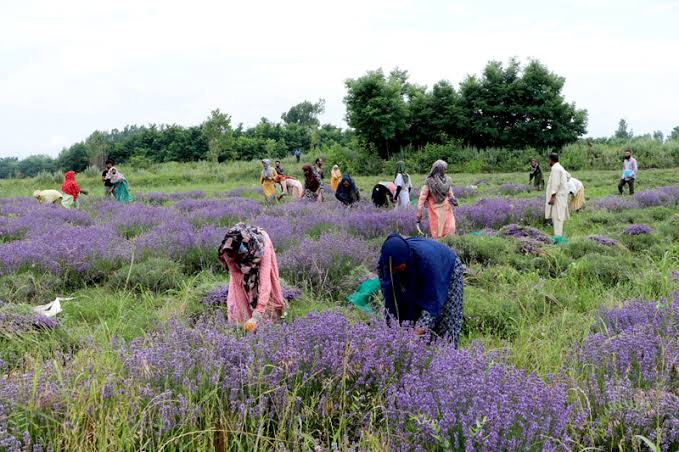Jahangeer Ganaie
Srinagar, Jul 15: The resurgence of lavender cultivation, known as the “Purple Revolution”, is currently being witnessed in Jammu & Kashmir. However, this is not a new phenomenon for Kashmir, which produced hundreds of kilograms of lavender around two decades ago.
In an exclusive interview with the news agency—Kashmir News Observer (KNO), Dr Abdul Sami Shawl, a well-known scientist formerly in charge of the CSIR Field Station Bonura (formerly CIMAP Field Station Bonura) in Pulwama, explained that lavender was initially introduced to Kashmir in the early 1970s.
He said the initiative was led by Dr Akhtar Hussain, the then Scientist In-charge of the Field Station and founder Director of the Central Institute of Medicinal and Aromatic Plants (CIMAP), Lucknow.
Dr Shawl said that after extensive efforts on varietal improvement, a new variety of lavender was developed and its large-scale cultivation began at the Pulwama Station. “Further genetic improvements led to the introduction of the variety known as B-18. With the propagation of this new variety among farmers, Kashmir used to produce around 700-800 kg of lavender oil,” he said, adding that Kashmir is the only temperate zone where even Mediterranean plants can be cultivated.
To promote lavender cultivation among farmers and small producers, the government introduced a buy-back scheme and connected growers with various businesses utilising lavender oil.
“Lavender cultivation was also promoted through a Public-Private Partnership (PPP) model, providing entrepreneurs with technical assistance and knowledge sharing for large-scale production,” the scientist said. “Distillation facilities at the Field Station were made available to growers under the PPP mode for oil extraction. Some entrepreneurs were also encouraged to cultivate lavender on government land holdings.”
In around 2005, then Chief Minister Mufti Mohammad Sayeed, who had a keen interest in lavender, developed a lavender park in Pahalgam. Following the initial success, entrepreneurs like Dr Ghazala and others brought around 2000 kanals of their land under lavender cultivation, Dr Abdul Sami said.
Although lavender was also introduced in Himachal Pradesh, Tamil Nadu, and other northeastern states, excessive rainfall during the flowering period hindered its expansion in these areas, he added.
Currently, Bhaderwah is recognised as the epicentre of the Purple Revolution, with farmers adopting lavender for its increased profitability compared to traditional crops. Since 2009, thousands of rooted lavender plants from the Pulwama Station of CSIR have been taken to Bhaderwah, promoting large-scale cultivation. As a result, more farmers are switching to producing lavender oil and dry flowers.
The CSIR Aroma Mission, an initiative under the Ministry of Science and Technology, has significantly promoted the cultivation of various industrially important aromatic crops, including lavender.
Other crops like rose, rosemary, and clary sage, also targeted under the Aroma Mission have the potential for similar exploitation due to the high market demand for their essential oils and value-added products, Dr Shawl said.
He said the essential oils produced in the valley meet international standards, comparable to those produced in Bulgaria and France, adding that efforts to strengthen market linkages and industry connections are crucial.
Lavender is widely used in perfumery, the floral industry, aromatherapy, and therapeutics in Europe. It has medicinal properties, including antibacterial and antidepressant effects. Aromatherapists use lavender in inhalation therapy to treat headaches, nervous disorders, and exhaustion, while herbalists treat skin ailments such as fungal infections, wounds, eczema, and acne with lavender oil. It is also used in healing baths for joint and muscle pain. Once planted, lavender can remain productive for around 20 years without the need for replanting.
Lavender cultivation is now widespread, providing a livelihood for hundreds of farmers. “There is a need for further genetic improvement and trait enhancement to develop improved cultivars that match international market standards,” Dr Shawl said, adding that efforts are ongoing at the Field Station Bonura Pulwama to achieve these goals—(KNO)




